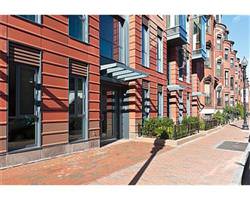Notes from Lands End
Where to Eat on a Winter Day in Province
By Laura Shabott
February 15th, 2014
Snow, wind and rain sharpen the palette for good hot food and friends to share it with. A surprising number of eateries are open this winter in Provincetown (and just over the border in Truro) for your culinary pursuits. Bon Appétit.
 |
A surprising number of restaurants and eateries are open this winter in Provincetown for your dining pleasure.
|
|
Blustery storms seem to be all the rage in the Northeast this season. When in doubt, please call ahead. Phone numbers are provided in the listings.
141 Bradford Natural Market:
508-487-9784 – 141 Bradford St. Open Daily
The comforting aroma of a vegetarian/vegan-friendly lunch buffet wafts through this airy whole foods store. Partners Joe Freitas and Chris Getman greet everyone by name and answer questions about vitamins, natural products and the benefits of juices pressed on premises. Visit their adorable West End spot open in season.
Angel Foods:
508-487-6666 – 467 Commercial Street (across from PAAM )
Open Daily.
Liz Lovarti brings her old world Italian sensibilities to this specialty food store. Who wouldn’t want one of the gift baskets filled with exotic breads, cheeses, divine figs and artesian waters? House-made hot dishes and sandwiches are a gourmet treat. Try out her new location in the West End this summer.
Bayside Betsy’s:
508-487-6566 – 177 Commercial St. Breakfast, Lunch & Dinner Weds.-Sunday
Bayside Betsy’s gets rave reviews from loyal locals as well as brides wanting a fun place for their reception. You can count on a relaxing meal with a lovely view of the harbor and friendly service. I’ve attended a number of functions there, both day and night, and they were flawless.
Central House at the Crown:
508-487-1430 x229 – 247 Commercial St. Lunch/Dinner Thurs.-Sunday
Chef Devon Gilroy and wine steward Peter Miscikoski dish up delicious rustic fare well paired with selections from artisanal vineyards. Reviewers rave about the famous lobster mac&cheese. Dine pre-performance and get preferred seating for one of the Crown and Anchor’sfabulous shows.
Chach:
508-487-1530 – 73 Shank Painter Rd. Daily 8am-2pm.
Revered for their French Toast with lemon curd, Chach and her kitchen make this a cozy diner with a never ending pot of coffee and an awesome daily special. Go alone or with a crowd. The lunch counter is a lot of fun and the food portions are truly generous.
Chequessett Chocolate:
774-538-6249 – 8 Highland Rd., No. Truro, Weds.-Sunday 10-4p.m.
After a visit to the jungles of Costa Rica in search of the perfect cocoa beans, culinary experts Katie Reed and Josiah Mayo have opened Chequessett Chocolate. Handcrafted confections, a beverage bar and free Wi-Fi make this an irresistibly sweet addition to the Outer Cape.
Ciro & Sal’s:
508-487-6444 – 4 Kiley Court -Open Daily.
Artists Ciro Cozzi and Sal Del Deo originally created this Italian restaurant to pay for canvases and oil paint. Now owned by long-time employee Larry Luster, the cuisine harkens back to the North of Italy with seafood, veal and pasta dishes in the intimacy of a wine cellar. This Provincetown institution is tucked away down a side street in the East End Gallery district.
East End Marketplace:
508-487-2337 -212 Bradford St. Open Daily.
Great breakfast sandwiches and decadent desserts add to the neighborhood ambience of this market owned by the personable Gary Pasnick with support from long-time resident Betty Vilari. Get groceries, cold beer and a nice bottle of wine or try your luck at the lottery.
Fanizzi’s by the Sea:
508-487-1964 539 Commercial St. Open Daily
This is waterfront dining at its best. The entire Provincetown Bay is your view as comfort foods are served in a casual atmosphere by a welcoming staff. The bar is a treat with a sweeping vista of the East End and great martinis. Group celebrations fit nicely at round tables for a Sunday brunch not to be missed.
Farland Provisions:
508-487-0045 – 150 Bradford St. (corner of Conwell St.) Open Daily
Partners James Farley and Tom Boland took a dying location and turned into a thriving deli and bakery with signature sandwiches and a delightful staff. Breakfast, lunch and take-out are in-house made. Catering services can accommodate groups from picnic to tent-size.
George’s House of Pizza:
508-487-3744 – 275 Commercial St. Open Daily.
There are days when a slice or a pizza delivered just feel so right. George’s Pizza offers that respite from cooking. Subs, combination pies (including white), a generous Greek salad with the real-deal olives and a piece of baklava make for a nice winter nosh. The computer games are a fun distraction.
Governor Bradford Restaurant and Bar:
508-487-2871 – 312 Commercial St. Open Daily
This year-round locals’ watering hole and restaurant makes winters go faster by hosting a Friday Fish Fry with Bubbles, a lively winter pool tournament on Wednesday nights and Drag Karaoke Saturday evenings hosted by Dana Danzel. If you have never seen her perform, grab the nearest bachelorette party and go sing along.
Mews Restaurant and Cafe:
508-487-1500 – 429 Commercial St. Open nightly.
Exceptional in every way, this Zagat rated restaurant boasts a vodka bar of over one hundred varieties. Owner Ron Robin and his fiercely loyal staff create a dining experience that both locals and tourists cherish. Reservations recommended.
Napi’s Restuarant:
800-571-6274 7 Freeman St. Lunch till Mid May, Dinner Daily
Napi and Helen Van Derek combine their love of world travel, food and Provincetown in this truly unique restaurant. Stain glass, carousel horses are displayed next to paintings by Provincetown masters. The meals are sumptuous, always fresh and served by a staff with their own local followings.
SKIP:
508-487-8331 10 Shank Painter Road United Methodist Church
Lunch 12:30p.m.-1:30p.m. Monday-Friday – Donations welcome.
The Soup Kitchen of Provincetown, a non-profit founded in 1992, feeds almost one hundred people a day. Chef Amy Howell says that the generosity of local restaurants and businesses, along with a remarkable staff of volunteers, brings what is best about Provincetown to our winter community. The onsite Thrift Store is a definite perk.
Squealing Pig:
508-487-5804 – 335 Commercial St. Open Daily.
Dave B. from Boston says, “My wife and I stopped in for lunch on a cold December afternoon and sat at the bar. We ordered Wellfleet oysters, one half dozen with cocktail sauce and one half dozen with the ginger, wasabi and soy. Stellar!” An Irish Pub known for its bevy of craft beers and burgers with a twist, no one leaves disappointed.
The Pointe Restaurant:
508-487-2365 – 82 Bradford St. Tues.-Sunday Dinner
The Crown Pointe Inn and Spa brings Food & Wine Magazine’s Top Ten Chef Robbin Haas to Provincetown. Diners are delighted with his fresh take on classic and modern American cuisine made with the finest local ingredients. This sea captain’s inn is a lovely perch at the crest of Bradford. Reservations welcomed.
Wired Puppy:
508-487-0017 – 379 Commercial St. Daily 6a.m-6p.m.
People with their pooches love to sip a cup of organic, fairly-traded coffee brewed to perfection. They chat, eat a muffin, use the free Wi-Fi and play with each other’s dogs in this hub of winter life. Donna Vaillancourt and her esteemed colleagues have created something very special.
A surprising number of restaurants and eateries are open this winter in Provincetown for your dining pleasure.
Next Week’s Notes from Lands End: Festivals 2014.
Provincetown author Laura Shabott has learned how to self-publish and is empowering others to do the same.Confessions of an eBook Virgin: What Everyone Should Know before They Publish on the Internet will guide you through the self-publishing process in a few hours of reading. Rated five stars, the book is available on Kindle, Nook and in Paperback.
Provincetown.com is the longest-standing, independently owned presence on the web in 02657.
Please like Provincetown.com on Facebook.

|














































